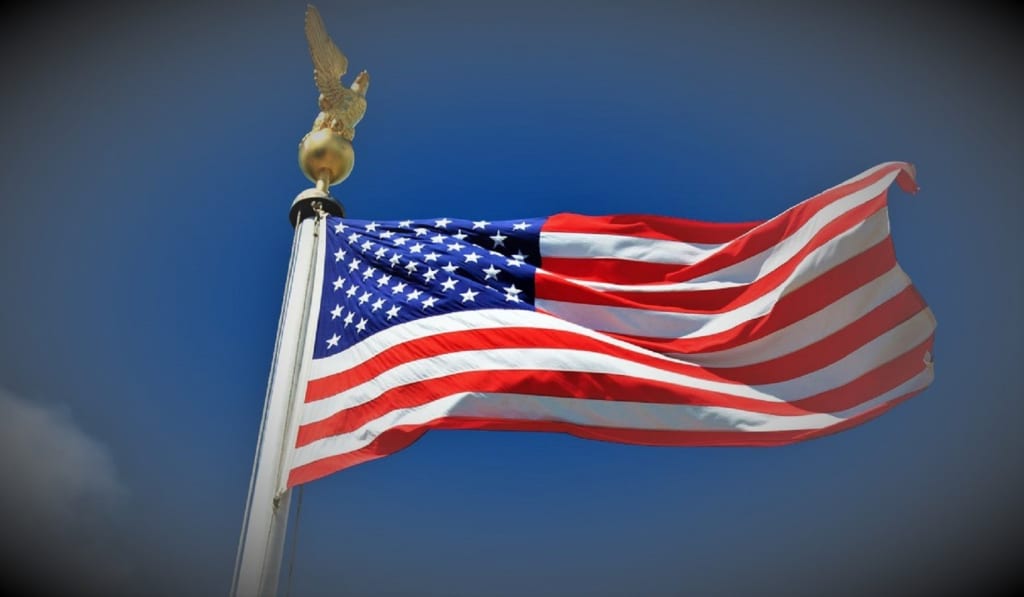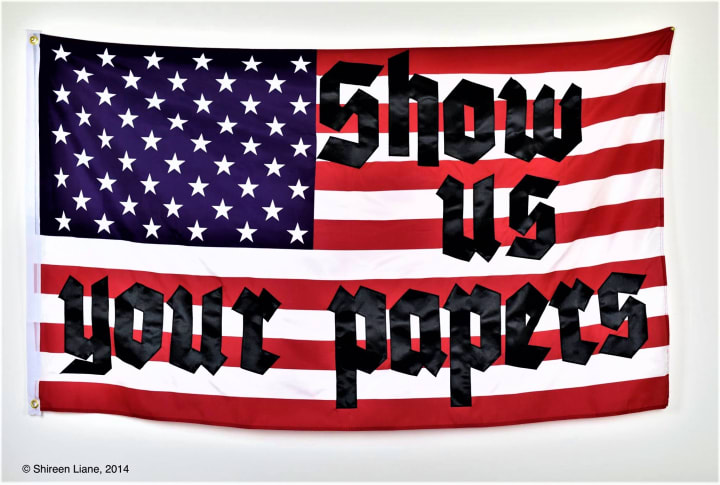Flag Day: celebrating the stars and stripes and the freedom of expression
Bearing the standard as a beacon of hope for what we can become

That the flag of the United States shall be of thirteen stripes of alternate red and white, with a union of thirteen stars of white in a blue field, representing the new constellation. — Adopted by the Continental Congress on June 14, 1777.
June 14 is Flag Day
This day commemorates the day in 1777 that the Second Continental Congress adopted the Stars and Stripes for the flag of the United States. In 1949, President Harry Truman proclaimed June 14 of each year as a national observance of Flag Day. With that in mind, this week is a good time to remind people that there is a law which provides requirements for the flag and guidelines for its proper use both at the government and private levels.
The Federal Flag Code, Public Law 94–344, includes rules for handling and displaying the flag of the United States. The flag we know as the “Stars and Stripes,” or “Old Glory” is a symbol of the ideals envisioned by the founders of this nation and the hopes of all citizens from the beginning until today. The code itself says, “The flag represents a living country and is itself considered a living thing” (8.j)
President Franklin D. Roosevelt stated it thusly in the introduction to his Proclamation Number 2605:
“The flag of the United States of America is universally representative of the principles of the justice, liberty, and democracy enjoyed by the people of the United States; and people all over the world.”
While the U.S. Flag Code is a federal law, following it is not mandatory. The language is non-binding and uses words like “should” rather than “must.” There are no penalties for not following the guidelines set forth in the code. Rather than being written to “proscribe conduct,” the code was written to “codify various existing rules and customs.”
The flag and Flag Day — a short history
No one really knows who created the American flag. As most American schoolchildren learned, many historians believe it was designed by Congressman Francis Hopkinson of New Jersey and sewn by Betsy Ross, a seamstress in Philadelphia.
The first time a flag with the stars and stripes design was carried into battle was on September 11, 1777, in the Battle of the Brandywine. On February 14, 1778, the USS Ranger, under the command of Captain John Paul Jones, sailed into a French port bearing the Stars and Stripes, where the Ranger’s flag was first US flag to be saluted by foreign naval vessels.
On March 17, 1824, when Captain William Driver of Salem, Massachusetts turned 21, his mother and some young women presented him with the gift of a flag for his ship. Captain Driver was reportedly thrilled to receive such a gift and declared, “I name her ‘Old Glory!’” The flag flew on the captain’s ship throughout his career, and when he retired to Nashville, Tennessee in 1837, he displayed “Old Glory” from a rope.
The story is that when Tennessee seceded from the Union in 1861, Captain Driver sewed his beloved flag inside a comforter to hide it. When Union soldiers entered Nashville on February 25, 1862, he took it out of the hiding place and went to the state capitol building, where he “proudly raised it for all to see.” Old Glory was passed down the generations of the Driver family until 1922, when the family donated the flag to the Smithsonian. It remains preserved under glass at the Institution today, and the term “Old Glory” has become another synonym for the Stars and Stripes.
While many places lay claim to have held the first Flag Day celebration, the one that is recognized most is one that took place in New York where, on June 14, 1889, the principal of a free kindergarten, Professor George Bolch, instituted patriotic ceremonies at his school to observe the anniversary of the Flag Day resolution. The State Department of Education later started having all public schools in New York observe the day with events. After that, the New York state legislature directed that the state superintendent of public schools would ensure that all schools held observances for Lincoln’s Birthday, Washington’s Birthday, Memorial Day, and Flag Day.
In 1897, the governor of New York ordered the displaying of the flag over all public buildings in the state. This is thought by some to be the first official recognition of the anniversary of the adoption of the flag outside the school system. On May 7, 1937, Pennsylvania became the first state to declare Flag Day as a legal holiday. Flag Day is a nationwide observance today, but only Pennsylvania recognizes it as a legal state holiday.
Bernard J. Cigrand, a school teacher at Stony Hill School in Waubeka, Wisconsin, had his pupils celebrate the American flag’s “birthday” on June 14, 1885. He is now considered by many to be the “Father” of Flag Day. On August 3, 1949, Congress approved the national observance of Flag Day, with President Harry Truman signing it into law. Before that, two presidents had issued proclamations asking for June 14 to be observed as the National Flag Day. These were Woodrow Wilson in 1916 and Calvin Coolidge in 1927.
The National Anthem and the flag
On March 3, 1931, the words and music known as The Star-Spangled Banner were designated as the national anthem of the United States of America. The lyrics came from a poem by Francis Scott Key called “Defence of Fort M’Henry.” The poem was written on September 14, 1814, after Key after witnessed the bombardment of Fort McHenry by British ships of the Royal Navy in the War of 1812. Key was inspired by seeing that the large U.S. flag known as the “Star-Spangled Banner” continued to fly triumphantly above the fort during the U.S. victory. The tune for The Star-Spangled Banner comes from a popular British song by John Stafford Smith entitled, “To Anacreon in Heaven.”
US Code 36 Chapter 10 not only designates the song as the national anthem, but also speaks to the use of the flag during the singing of the anthem.
Against the Code: an example
7(b). The flag should not be draped over the hood, top, sides, or back of a vehicle or of a railroad train or a boat. When the flag is displayed on a motorcar, the staff shall be fixed firmly to the chassis or clamped to the right fender.
8(k) The flag, when it is in such condition that it is no longer a fitting emblem for display, should be destroyed in a dignified way, preferably by burning.
Although the PL 94–344 is a voluntary code, there are many who feel that following the recommended etiquette for the use of the flag is a necessary aspect of true patriotism. However, in recent years, this veteran and former Patriotic Instructor for the Veterans of Foreign Wars (VFW) Auxiliary has observed a number of individuals who claim to be patriots and “all about the flag,” yet seem to be unaware of the code.
Many of these individuals have been among the first to denigrate citizens who use the flag as protest against inequities and oppression.
An example of a “patriot” who seems to be unaware of the code is a driver of a truck who has mounted a flagpole with an American flag in the center of the bed of the truck. The flag may be attached securely, but it is not affixed to the chassis or the right fender, as the Flag Code directs. The flag, having been flying at freeway speeds for an unknown amount of time, is filthy dirty and ragged. The edges are ripped.
Not only is this against the flag code, but to the eye of one who is familiar with the code, this is an example of treating the flag with extreme disrespect.
Lesser “offenses”
8(i) The flag should never be used for advertising purposes in any manner whatsoever. It should not be embroidered on such articles as cushions or handkerchiefs and the like, printed or otherwise impressed on paper napkins or boxes or anything that is designed for temporary use and discard. Advertising signs should not be fastened to a staff or halyard from which the flag is flown.
8(j) No part of the flag should ever be used as a costume or athletic uniform. However, a flag patch may be affixed to the uniform of military personnel, firemen, policemen, and members of patriotic organizations. The flag represents a living country and is itself considered a living thing. Therefore, the lapel flag pin being a replica, should be worn on the left lapel near the heart.
Enter just about any store around Memorial Day, Independence Day, or Veterans Day, and there are blatant examples of the U.S. Flag Code being broken. In fact, any advertisement online, on television, or any other location near these holidays makes it clear that either those who design products do not know the code or choose break it for their own purposes simply because they can.
Everything from underwear, t-shirts, and shorts, socks and shoes, hats and jackets, to paper plates, cups, and napkins have the flag printed on them. Cars and trucks are painted with the flag, billboards display advertising illustrated with the flag, and even credit cards and beer cans have the flag printed on them. The sheer inundation of flag designs on these items and in advertising smacks of disrespect rather than patriotism. The message seems to be that when they purchase the product advertised, buyers are more patriotic than those who do not.
Sometimes it seems as if “Old Glory” is nothing more than another pattern to be used to sell products.
The Flag as protest
The American flag has been used as a form of protest since at least the Civil War, when southerners removed it from display. They felt that the flag they had once loved stood for a federal government that did not respect their rights and threatened their way of life. The first flag burnings in the U.S. are recorded as happening in the south as a protest against Abraham Lincoln. During a Central Park rally against the Vietnam War in 1967, a flag was burned in protest. This act sparked a 1968 anti-flag desecration law that was overturned a year later.
Congress enacted the Flag Protection Act in 1989 after a Supreme Court decision held that a state law prohibiting flag burning was unconstitutional. The 1989 decision provides that anyone who knowingly desecrates the flag may be fined and/or imprisoned for up to one year. However, the Flag Protection Act was challenged by the Supreme Court in a 1990 decision that it violates the First Amendment free speech protections.
The first time the flag was brought up in relation to free speech was in 1943 when the Supreme Court held that public school children could not be compelled to salute the U.S. flag in the case of West Virginia Board of Education v. Barnette (319 U.S. 624). Justice Robert H. Jackson championed the importance of freedom of expression under the First Amendment when he wrote:
“Freedom to differ is not limited to things that do not matter much. That would be a mere shadow of freedom. The test of its substance is the right to differ as to things that touch the heart of the existing order. If there is any fixed star in our constitutional constellation it is that no official, high or petty, can prescribe what shall be orthodox in politics, nationalism, religion or other matters of opinion.”
Photographer Robert Mapplethorpe, whose body of work has elicited controversy for many reasons, captures a sense of disappointment and loss in his photo “American Flag.” The black and white photo is a depiction of a tattered flag, billowing in the breeze, with the sun obscured by the starry field. When the photo was displayed in the “In Focus Protest” exhibit at the Getty Center in 2021, the blurb that accompanied the photo read, “Mapplethorpe evoked the frayed character of American ideals during a period when equal rights for gay men and women in the United States seemed nearly unimaginable.”
Feminist musician, artist, and activist Shireen Liane creates protest flags which underscore the point that the nation which the flag represents often does not follow through on the promise of liberty for all. Liane’s flags have been carried at protests in the United States and the United Kingdom. Some of the events where her flags have appeared are a Get Out the Vote Parade in New York, a march for reproductive freedom, and on a billboard for reproductive rights. In addition to these issues, Liane works in support of LGBTQIA and trans rights, equal pay, and immigration.

USC 36, Chapter 10, 170. National anthem; Star-Spangled Banner The composition consisting of the words and music known as The Star-Spangled Banner is designated the national anthem of the United States of America.
171. Conduct during playing
During rendition of the national anthem when the flag is displayed, all present except those in uniform should stand at attention facing the flag with the right hand over the heart. Men not in uniform should remove their headdress with their right hand and hold it at the left shoulder, the hand being over the heart. Persons in uniform should render the military salute at the first note of the anthem and retain this position until the last note. When the flag is not displayed, those present should face toward the music and act in the same manner they would if the flag were displayed there.
At sporting events, the national anthem is played while all present are expected to stand, hand on their hearts, and face the flag. On September 1, 2016 football player Colin Kaepernick and his teammate Eric Reid chose to kneel in protest against the lack of attention given to the issues of racial inequality and police brutality in the United States.
Since that day, “taking a knee” became a widely used form of protest, specifically as a protest against racism. Sports players and others around the world adopted this form of protest. Reid is quoted in the New York Times as saying, “We chose to kneel because it’s a respectful gesture. I remember thinking our posture was like a flag flown at half-mast to mark a tragedy.”
In spite of the fact that Kaepernick and Reid felt that kneeling was a “respectful gesture,” it created a rather loud backlash from some factions. The protesters were declared “treasonous.” Kaepernick received death threats and was told to leave the country. Like the Federal Flag Code, USC 36 Chapter 10, Patriotic Customs, which delineates the etiquette during the national anthem, is a guideline with no penalty for behaving differently. When the players took the risk of losing their positions by taking a knee in protest, they surely felt that they were simply exercising their first amendment right to freedom of expression.
8(a) The flag should never be displayed with the union down, except as a signal of dire distress in instances of extreme danger to life or property.
Driving through a nearby neighborhood, someone notices an American flag flying on a tall pole. However, there’s something wrong. The flag is upside down. The driver wonders if they should have the authorities check on the person. Are they in danger of the loss of life or property? No, there’s a placard in the yard which reveals that the resident disagrees with the result of a recent election. The resident is making a statement about their political opinion and their disappointment that their candidate of choice did not win. They are indicating that they feel somehow endangered because they are upset that an election by the people through the electorate resulted in a candidate whom they didn’t like taking office.
This is a nation where all citizens are meant to have the right to a different opinion from one another. It is this right, and the opportunity to have those opinions heard, that makes the United States different from an autocracy. As long as the people have the right and the ability to vote, the group of elected officials one dislikes will undergo a change in the time allotted to the current regime.
“Old Glory” represents this freedom to have a choice in how the government works. The flag not only stands for the rights Americans hold dear, but it also embodies a future ideal in which all citizens have the same rights that were once only allotted to a few. Using the flag as a means to oppose inequality, oppression, and inequity is well within the rights of Americans as a form of free speech.
It is the constitutional right to free speech that has brought the nation forward and will continue to do so into the future.
Personal reflection
As a member of Generation Jones born in the late 1950s, I remember diving under desks for duck-and-cover drills in case of nuclear attack in primary school. I remember seeing the Vietnam War, anti-war protests, and racial unrest depicted on the television in the living room throughout my childhood.
I was raised to be patriotic. My maternal grandfather fought in WWI, my father served in the Navy during the Korean War, and my mother was in the Air Force Reserve until she married in 1956. I proudly stood up for the Pledge of Allegiance, sang “Make America proud of you in everything you say and do/Make America proud to say that you’re a son or a daughter of the USA!” at Friday assemblies in elementary school, and when I graduated from high school, I joined the Air Force.
I was, and still am, a patriotic person.
At the same time, I am horrified by war, the hatred I have seen revealed in the news, and the stories I’ve heard from folks who have experienced the worst of our fellow Americans. As the years have passed, I’ve learned more about inequity. I understand the disappointment people like Mapplethorpe, Kaepernick, and many others have felt when they looked to their nation for support and found themselves ostracized.
This is not a perfect nation; indeed, there is no perfect government, and it’s likely there will never be one. Human beings are imperfect. However, we can strive for perfection. We can work toward improvement. The founders of our nation knew they had not reached the apex of human development, but I believe that in spite of their shortcomings, they had a vision toward a “more perfect union.”
No, we are not there yet, but each of us can take steps toward that vision.
For me, the flag represents that vision. It is the rallying point for our cooperation and improvement. It is a beacon of hope and a promise that the United States will one day truly be the “land of the free” for all of its citizens. Using the flag as a form of protest against inequity and creating artistic statements of love and declarations of independence from prejudice and violence are valid uses for the standard of a country established on the premise of freedom of expression.
The flag is a powerful symbol, yet only those who have a healthy respect for the flag and what it represents have the ability to utilize its power effectively.
Those who use it as a banner to hide fears and hatred and call it “patriotism” are not holding up the promise inherent in the Constitution. Those who use the flag as a statement of their own beliefs but deny that right to their fellow citizens do not respect what it stands for. In fact, they are denying the vision of the founders, and they are rejecting the service of those who have given their time, effort, and even their lives, to protect the rights of all Americans to speak their minds and to live into the promise of life, liberty, and the pursuit of happiness.
This Flag Day, I encourage you to take the time to read the U.S. Flag Code. Follow up with the information on the national anthem in USC 36, Chapter 10.
***
This story first appeared on Newsbreak
About the Creator
Suzy Jacobson Cherry
Writer. Artist. Educator. Interspiritual Priestess. I write poetry, fiction, nonfiction, and thoughts on stuff I love.
Enjoyed the story? Support the Creator.
Subscribe for free to receive all their stories in your feed. You could also pledge your support or give them a one-off tip, letting them know you appreciate their work.






Comments
There are no comments for this story
Be the first to respond and start the conversation.